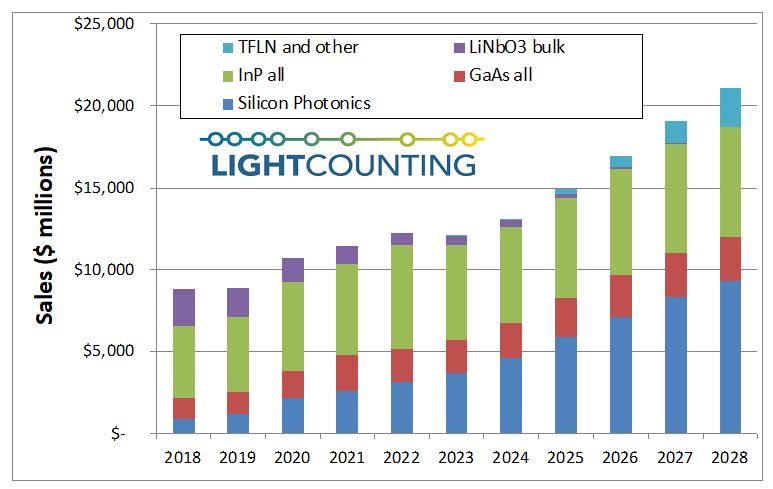LightTrends Newsletter

Tracking the industry transitions
LightCounting releases the 9th edition of its Silicon Photonics report with a new market forecast for linear drive pluggable and co-packaged optics
Many in the industry have predicted that silicon photonics (SiP) will enable inexpensive, mass-produced optical connectivity, radically changing the optical components and modules industry. Forecasting the timing of such transitions is challenging: nothing seems to happen for a while until suddenly the change is here for everyone to see. In case you have not noticed, silicon photonics (SiP) is one of the mainstream technologies of the global market for optical transceivers now, as illustrated in the figure below.
We expect that market share of transceivers using SiP-based optical modulators will increase from 24% in 2022 to 44% by 2028. Even more interesting is that modulators based on other thin film materials can be manufactured on silicon wafers and combined with a wide range of optical elements and electronic ICs, using SiP as the integration platform. These materials currently include Thin Film Lithium Niobate (TFLN), Barium Titanate (BTO) and electro-optics polymers, which we combined into a “TFLN and other” category in the figure.
Another exciting transition in the industry is the adoption of linear drive pluggable (LPO) transceivers and co-packaged optics (CPO). Both solutions offer significant reductions in power consumption in comparison with standard re-timed transceivers with PAM4 DSP chips inside them. Removing the DSPs saves power, but more complex SerDes are needed to make direct drive possible.
Broadcom’s 100G SerDes were developed with CPO in mind, but it seems to support LPO as well. Early results for 800G LPO modules driven by 100G SerDes are very encouraging. It is very unlikely that LPO will work with 200G SerDes, however, so CPO may be the only option for 1.6T ports.
Will all LPO and CPO solutions be based on SiP technology? Most likely not, but SiP is the current front runner and the ideal integration platform for new materials as well. SiP modulators are currently the best option for linear drive designs, since GaAs directly modulated lasers (DMLs) and InP electro-absorption modulated lasers (EMLs) are more “non-linear” devices. Perhaps not all solutions will use SiP modulators, but it is safe to predict that all LPO/CPO devices, except for VCSELs, will be based on a SiP platform. All the new materials (TFLN, BTO and polymers) will use a SiP platform for integration with other optical elements and electronics.
This report presents a new forecast for LPO and CPO sorted by reach and data rate. Conventional re-timed pluggables will continue to dominate the market for the next 5 years, and probably longer than that. However, LPO/CPO ports will account for more than 30% of the total 800G and 1.6T ports deployed in 2026-2028. As usual, nothing may happen for a while until suddenly this change is here for all of us to see.
